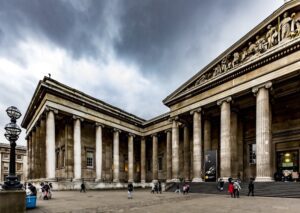
Anyone familiar with the Minoans has probably heard the term, “the first European civilization,” applied as a descriptor for this ancient society, best known historically in the popular literature as the subject of investigation by archaeologist Arthur Evans, who named the civilization after king Minos, the mythical king who reigned over the ancient Bronze Age city of Knossos on present-day Crete. And while the phrase may still hold some weight among many scholars of today, it likely also reflects the cultural and colonial mindset and disposition of the scholars and others whose lives and studies touched on the sensational discoveries that brought this advanced, early Aegean island society into the public light during the late 19th and early 20th centuries.
Enter here PhD candidate Mnemosyne Rice, who has been intensely researching the Minoans as part of her studies in Minoan Archaeology at Trinity College, Dublin. She discusses this and other related topics in the newly released Episode 5 of the new podcast series, Aegean Connections, hosted by Dr. Ester Salgarella. In this podcast episode, entitled Decolonizing the past: the legacy of Minoan Archaeology, Rice relates that, at least in part, what we have traditionally known about the Minoans has also been about the way the material discoveries were originally and traditionally interpreted by the gentlemen scholars and others who were influenced by the environment of European Colonialism that existed at the time of their discoveries. With this knowledge and with the development of a revised understanding of the ancient Minoan people, Rice has focused her PhD thesis on the evolution and intellectual history of how the material evidence of this civilization has been presented in museums, most particularly the British Museum in London and the Ashmolean Museum in Oxford, both of which curate and present limited collections and exhibitions of the same.
Rice also discusses the production of Linear A inscriptions (a largely undeciphered administrative script, and one of three scripts produced or used by the Minoans) as a craft, particularly on so-called non-administrative objects, such as stone vessels. She also describes and discusses her work on the project, The Many Lives of a Snake Goddess, which collects and studies the subsequent reuses of the famous Minoan Snake Goddess figure, which was first unearthed in the form of figurines at the Minoan palatial site of Knossos on Crete.
Anyone can listen to Episode 5 for free at the podcast series, Aegean Connections.
Cover Photo, Top Left: British Museum, hulkiokantabak, Pixabay
____________________________
Advertisement

EXPLORE THE ANCIENT ETRUSCANS IN PERSON!
Experience a unique, up-close-and-personal hike among ancient hilltop towns in central Italy. You will walk the sensational countryside of the regions of Umbria and Tuscany, soaking in important sites attesting to the advanced Etruscan civilization, forerunners of the ancient Romans; imposing architectural and cultural remains of Medieval Italy; local food and drink; and perhaps best of all — spectacular scenic views! Join us in this collaborative event for the trip of a lifetime!




